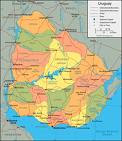:::::::::::::::::::::::::::::::::::::::::::::::::::::::::::::::::::::::::::::::::::::::::::::::::::::
THE SOUTH AMERICAN SAIJIKI
- URUGUAY
:::::::::::::::::::::::::::::::::::::::::::::::::::::::::::::::::::::::::::::::::::::::::::::::::::::
This saijiki is under construction.

Uruguay (official full name in Spanish: República Oriental del Uruguay; pron. IPA: , Eastern Republic of Uruguay) is a country located in the southeastern part of South America. It is home to 3.46 million people, of which 1.7 million live in the capital Montevideo and its metropolitan area.
It is bordered by Brazil to the north, by Argentina across the bank of both the Uruguay River to the west and the estuary of Río de la Plata to the southwest, and the South Atlantic Ocean to the southeast. It is the second smallest independent country in South America, larger only than Suriname and the French overseas department of French Guiana.
Montevideo was founded by the Spanish in the early 18th century as a military stronghold. Uruguay won its independence in 1828 following a three-way struggle between Spain, Argentina and Brazil. It is a constitutional democracy, where the president fulfills the roles of both head of state and head of government.
The economy is largely based on agriculture (making up 10% of GDP and the most substantial export) and the state sector, and relies heavily on world trade. Consequently, it is affected by any change in global prices. However, Uruguay's economy is on the whole more stable than in its surrounding states, and it maintains a solid reputation with investors.
Climate
The climate in Uruguay is temperate: it has warm summers and cold winters.
The predominantly gently undulating landscape is also somewhat vulnerable to rapid changes from weather fronts. It receives the periodic influence of the polar air in winter, and tropical air from Brazil in summer. Without mountains in zone that act as a barrier, the air masses freely move by the territory, causing abrupt weather changes.
The coolest month is June, while the warmest is January. The rainfall is equally distributed throughout the year, but tends to be a bit more frequent in the autumn months. There can be frequent thunderstorms in the summer. Snow is not very common.
© More in the WIKIPEDIA !
:::::::::::::::::::::::::::::::::::::::::::::::::::::::::::::::::::::::::::::::::::::::::::::::::::::
Kigo in alphabetical order
Jacaranda tree
:::::::::::::::::::::::::::::::::::::::::::::::::::::::::::::::::::::::::::::::::::::::::::::::::::::
Topics in alphabetical order
:::::::::::::::::::::::::::::::::::::::::::::::::::::::::::::::::::::::::::::::::::::::::::::::::::::
Carlos Fleitas
© Millikin University / by Mahrya Fulfer
Carlos Fleitas was born in Uruguay, South America and still resides there in Montevideo, which is Uruguay's capital city. He writes haiku, prose, and essays in both Spanish and English.
This 51 year old writer, has a wife and a daughter that live with him. He attended school at Stella Maris College (Christian Brothers)-School and High School and obtained a University Degree in Psychology. from "Instituto de FilosofÌa Ciencias y Letras.” He is married and has one daughter.
Viento de Verano
Junto pètalos de rosa
y los dejo ir
In my way home
grapes ripen in the fields
a sip of wine
:::::::::::::::::::::::::::::::::::::::::::::::::::::::::::::::::::::::::::::::::::::::::::::::::::::
quoted from
Musicality in Haiku
Written in Spanish: a Platonism?
Rhyme
The use of rhyme is one of the major ways of bringing musicality to a haiku. The two standards are consonant and assonant rhyme. Consonant rhyme in Spanish happens when the last accented vowel of the verse, and all vowels and consonants that may follow it, are the same in all the rhymed words.
La playa sola
mecidas por las olas
las caracolas...
This fine haiku, written by Malena Imas (Uruguay, South America) is a clear example of consonant rhyme. The musicality here is brought, not only by means of the use of the consonance, but also as its rhyme merges with the content of the haiku; that is, the waves of the sea with its natural rhythm, and the landscape of a seashore in which the conches are gently rocked, as if it where a lullaby...
Internal rhyme (rima interior): the use of a word in the interior of a verse that rhymes with an other word of the verse.
en este camino
solo el monono trino
del teru-teru
© Carlos Fleitas, WHR
:::::::::::::::::::::::::::::::::::::::::::::::::::::::::::::::::::::::::::::::::::::::::::::::::::::
BACK TO
SOUTH AMERICAN SAIJIKI
Back to the Worldkigo Index
http://worldkigodatabase.blogspot.com/
:::::::::::::::::::::::::::::::::::::::::::::::::::::::::::::::::::::::::::::::::::::::::::::::::::::





No comments:
Post a Comment